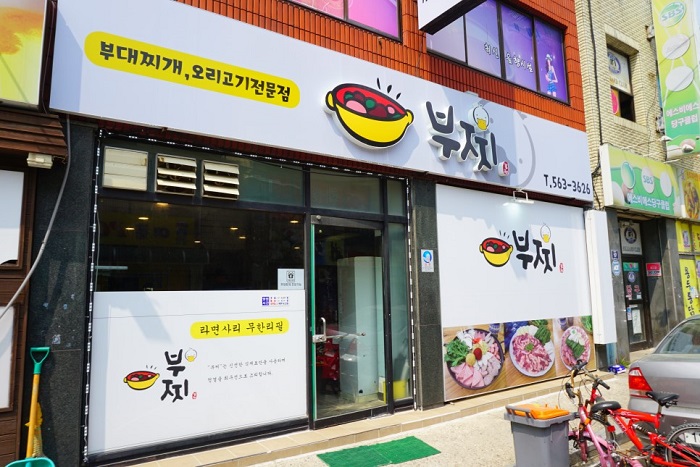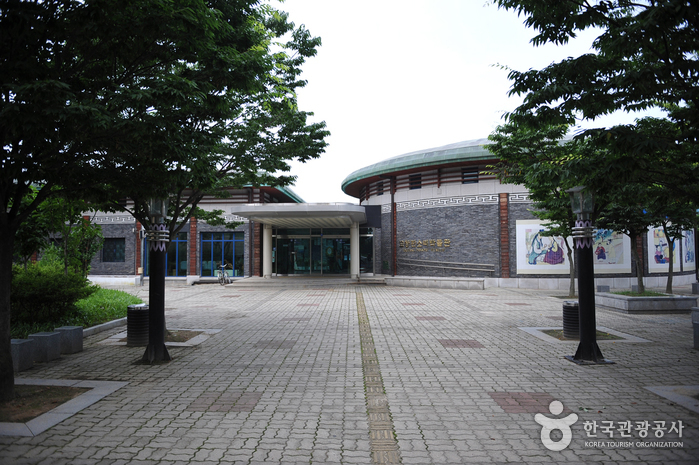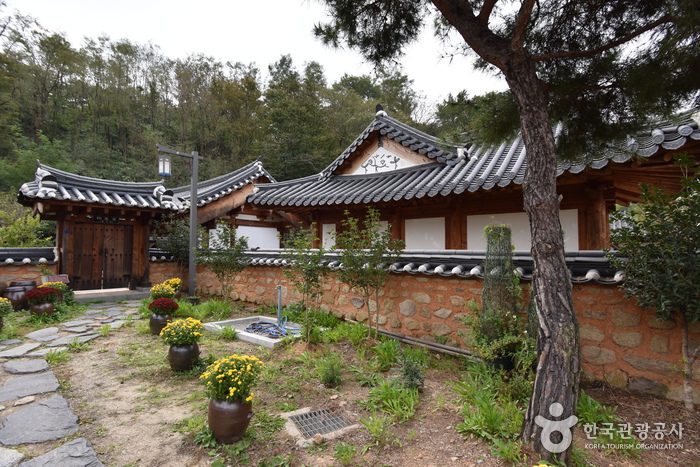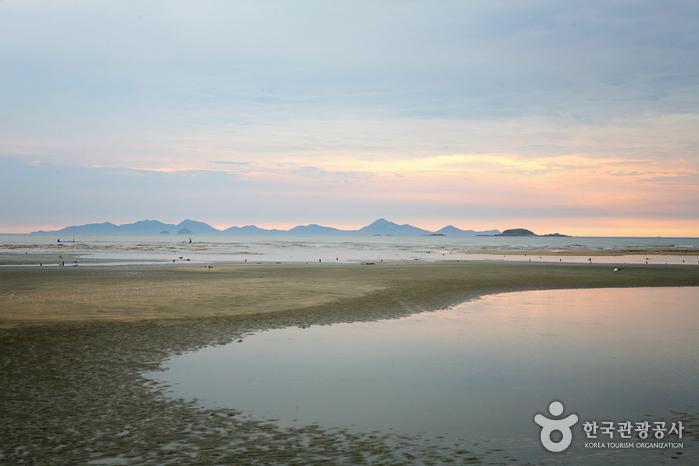Cheongwon Garden (청원가든)
14.9Km 2025-04-22
67 Seonunsa-ro, Asan-myeon, Gochang-gun, Jeonbuk-do
This restaurant is one of the most positively reviewed restaurants serving freshwater eels near Seonunsa Temple’s entrance for its clean ambience and delicious side dishes. If you order jangeogui here, the eel is salted or basted with sauce in the kitchen and brought to you for grilling.
Bujji (부찌)
15.2Km 2024-04-07
15, Seongsan 2-gil, Gochang-gun, Jeonbuk-do
+82-63-563-3626
This is a place where you can taste duck meat and the representative dish budaejjigae (spicy sausage stew). This Korean dishes restaurant is located in Gochang-gun, Jeollabuk-do. The most famous menu is sausage stew.
Gochang Pansori Museum (고창판소리박물관)
15.5Km 2024-04-06
100, Dongni-ro, Gochang-gun, Jeonbuk-do
+82-63-560-8061
The Gochang Pansori Museum was established in the old residence of ‘Dongni’ Sin Jae-Hyo (a musical theorist and arranger and a sponsor of Pansori) with the aim of honoring the great Pansori singers of the past (including Sin Jae-Hyo) and preserving and developing the indigenous tradition of Pansori. Of the original rooms of the residence only Sarangchae (an annex where men used to study or welcome guests) has been renovated and is open to the public. Right next to Sarangchae is the Dongni Gugakdang (Korean Traditional Music Hall).
Over 1,000 pieces related to Pansori and great local singers are on display at the museum, included personal possessions once owned by Sin Jae-Hyo (penname ‘Dongni’). For those interested in learning more about the traditional art of Pansori music or experiencing high-quality Pansori, the Gochang Pansori Museum is a must-visit travel destination.
Sin Jae-hyo's House (고창 신재효 고택)
15.5Km 2024-04-07
100, Dongni-ro, Gochang-gun, Jeonbuk-do
+82-63-560-2943
Sin Jae-hyo (1812-1884) was a legendary theorist, director, and sponsor of pansori (epic chant). Sin Jae-hyo's House in Gochang was built in 1850, and visitors can observe sarangchae (main room), an old well, and a paulownia tree preserved to this day. Sin was not a singer himself but a pansori enthusiast, and he used wealth to train potential singers and contribute to the growth of pansori. He also compiled and edited six pansori madangs (operas) titled Ttoggi Taryeong, Bak Taryeong, Simcheongga, Jeokbyeokga, Chunhyangga, and Garujigi Taryeong, of which only five are passed down. To honor his contributions and passion for pansori, Dongni Gugakdang was founded behind this house.
Gochangeupseong Walled Town (고창읍성)
15.5Km 2025-01-07
1, Moyangseong-ro, Gochang-gun, Jeonbuk-do
+82-63-560-8067
Gochangeupseong Walled Town was built in 1453 during th reign of Joseon King Danjong to protect the city from foreign invaders. The walls were built by the local civilians, using natural resources as they were available. Also called Moyangseong Fortress, the walled town served a vital role in protecting the southern region, and was designated Historic Site No. 145 on April 1, 1965. The walls are 4~6 meters high and 1,684 meters long, with three gates on the north, east, and west walls, each protected by curved walls. Inside the large area there were 22 government buildings. Restoration work on the wall has been ongoing since 1976.
Yeongi Sikdang (연기식당)
15.5Km 2025-04-22
전북특별자치도 고창군 아산면 선운대로 2727
This restaurant is the first to offer grilled freshwater eel in Gochang. The eel is grilled in the kitchen, so you don’t have to worry about the often smoky business of charcoal-grilled on the table.
Gochang-eup Sunghanok Village (고창읍성한옥마을)
15.7Km 2024-08-05
128 , Dongni-ro, Gochang-gun, Jeonbuk-do
+82-63-563-9977
Gochangeupseong Hanok Village is a group of houses once attached to the government office inside the ancient Gochangeupseong Fortress, Gochang-gun, Jeollabuk-do. It consists of seven tile-roofed houses containing 11 comfortable guest rooms with wooden floors, equipped with toilet and AC. There is a yard, and visitors can walk a trail to Gochangeupseong Fortress and ponder the impressive 500 year-old walls. There is a pottery and an embroidery experience center, and Yangpyeong Military Art Museum, Gochang Pansori Museum, and Seonun Golf Course are all nearby. Visitors can use the village’s large parking lot.
Gochang Munsusa Temple (문수사 (고창))
16.2Km 2024-04-07
135, Chilseong-gil, Gochang-gun, Jeonbuk-do
+82-63-562-0502
Nestled on the slope of Munsusan Mountain (alt. 621 m) in Gochang, Jeollabuk-do and Jangseong, Jeollanam-do, Munsusa Temple is located in the area of a dense mountain ridge to the west of Gosu Kiln Site in Gosu-myeon, and Josan Reservoir. The ridge features clean water and a thick forest that has remained uncontaminated due to its isolated location.
The temple's establishment date is uncertain. The temple houses Daeungjeon Hall (Local Tangible Cultural Heritage No. 51) and Munsujeon Hall (Local Tangible Heritage No. 52), as well as Myeongbujeon and Hansanjeon Halls. Daeungjeon is a small building featuring the unique architecture of gable roofing. Visitors will be fascinated by the temple's scenery, boasting valley waters flowing from dense forests. It is particularly beautiful in fall, when the autumn foliage harmonizes well with the colors of the old temple. The temple grounds are surrounded by a colony of maple trees 100 to 400 years old.
The Forest of Maple Trees at Munsusa Temple, Gochang, was designated in 2005 as Natural Monument No. 463. It covers the area from the entrance of Munsusan Mountain to the entrance of Munsusa Temple with nearly 500 maple trees lining the 80 meter-long path.
Dongho Beach (동호해수욕장)
16.6Km 2025-01-08
Dongho-ri, Gochang-gun, Jeonbuk-do
+82-63-560-2646
Dongho Beach is located south of Gomsoman Bay, between the Byeonsan Peninsula of Buan and Gochang-gun, Jeollabuk-do. Skirting the 1-kilometer-long white sandy beach lies a green forest with pine trees hundreds of years old. The sunset viewed from the forest is particularly eye-catching as the soft pink from the falling sun covers the sky. The water just offshore is relatively shallow, varying in depth between 0.5 and 1.5 meters. The high salt content in the seawater makes it an ideal place for sea and sand bathing.
On the hill above the forest is Suseongdang, a shrine honoring the god of the seas, where the local fishermen gather each year to pray for big catches.
National Jangseong Healing Forest (국립장성치유의숲)
16.7Km 2024-02-20
716 Chuam-ro, Seosam-myeon, Jangseong-gun, Jeollanam-do
National Jangseong Healing Forestis a natural recreational facility located in the Chungnyeongsan National Forest, opened in 2011. Visitors can be relaxed by walking along the cypress forest trail emitting phytoncides. There are seven hiking courses designed with various themes and slopes. Following the main course, the "Well-being Forest Path," hikers will encounter the Chungnyeongsan Observatory, where they can enjoy panoramic views of the mountain and see the cypress forest at a glance.








 English
English
 한국어
한국어 日本語
日本語 中文(简体)
中文(简体) Deutsch
Deutsch Français
Français Español
Español Русский
Русский